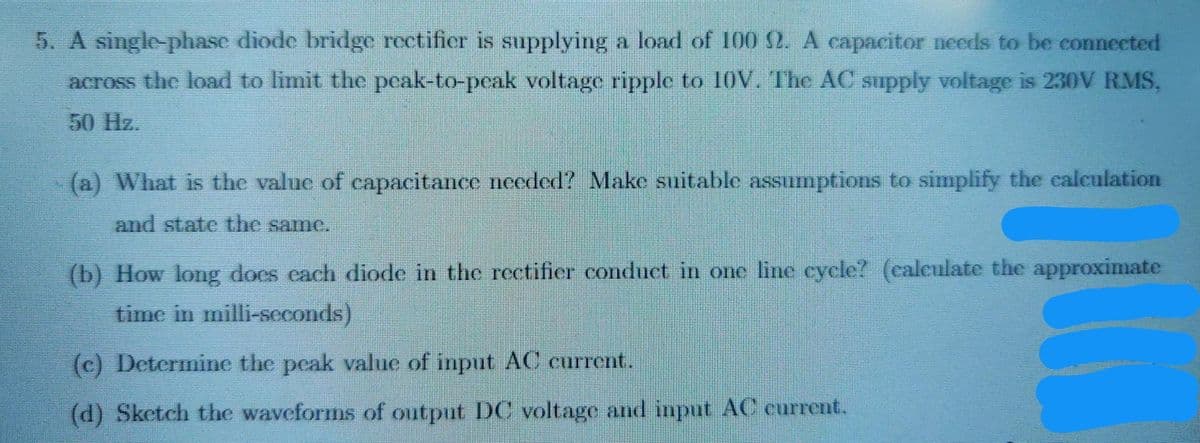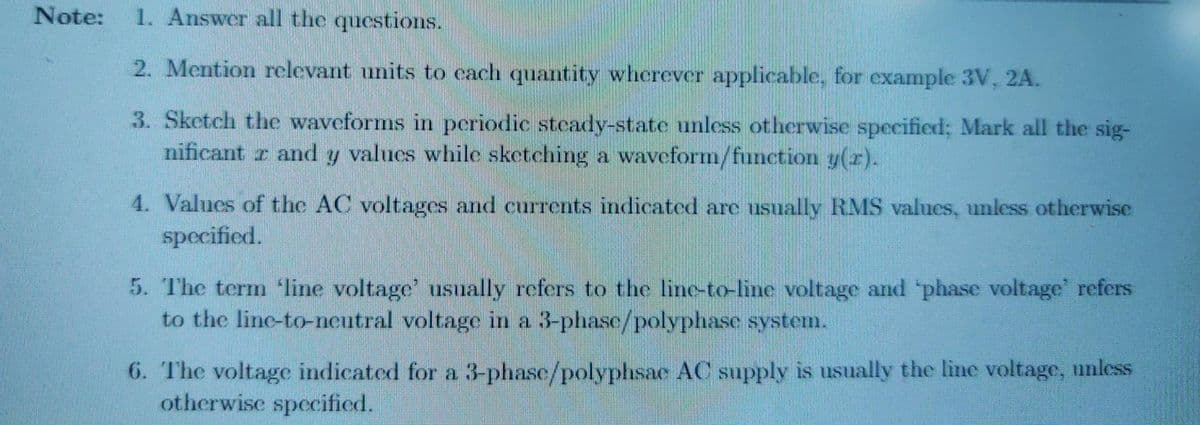5. A single-phase diode bridge rectifier is supplying a load of 100 2. A capacitor needs to be connected across the load to limit the pcak-to-peak voltage ripple to 10V. The AC supply voltage is 230V RMS, 50 Hz. (a) What is the value of capacitance needed? Make suitable assumptions to simplify the calculation and state the same. (b) How long does cach diode in the rectifier conduct in one line cycle? (calculate the approximate time in milli-seconds) (c) Determine the peak value of input AC current. (d) Sketch the waveforms of output DC voltage and input AC current.
5. A single-phase diode bridge rectifier is supplying a load of 100 2. A capacitor needs to be connected across the load to limit the pcak-to-peak voltage ripple to 10V. The AC supply voltage is 230V RMS, 50 Hz. (a) What is the value of capacitance needed? Make suitable assumptions to simplify the calculation and state the same. (b) How long does cach diode in the rectifier conduct in one line cycle? (calculate the approximate time in milli-seconds) (c) Determine the peak value of input AC current. (d) Sketch the waveforms of output DC voltage and input AC current.
Chapter59: Motor Startup And Troubleshooting Basics
Section: Chapter Questions
Problem 12SQ: How is a solid-state diode tested? Explain.
Related questions
Question
100%
Please provide answer of part d. I don't nead a,b,c answers.
Answer (a)-6.51mF
Answer (b)-31.4ms
Answer (c)-3.25A

Transcribed Image Text:5. A single-phase diode bridge rectifier is supplying a load of 100 2. A capacitor needs to be connected
across the load to limit the peak-to-peak voltage ripple to 10V. The AC supply voltage is 230V RMS,
50 Hz.
(a) What is the value of capacitance needed? Make suitable assumptions to simplify the calculation
and state the same.
(b) How long does cach diode in the rectifier conduct in one line cycle? (caleulate the approximate
time in milli-seconds)
(c) Determine the peak value of input AC current.
(d) Sketch the waveforms of output DC voltage and input AC current.

Transcribed Image Text:Note:
1. Answer all the questions.
2. Mention relevant units to cach quantity wherever applicable, for example 3V, 2A.
3. Sketch the waveforms in periodic steady-state unless otherwise specified; Mark all the sig-
nificant r and y values while sketching a waveform/function y(r).
4. Values of the AC voltages and currents indicated are usually RMS values, unless otherwise
specified.
5. The term line voltage' usually refers to the line-to-linc voltage and 'phase voltage' refers
to the line-to-neutral voltage in a 3-phase/polyphase system.
6. The voltage indicated for a 3-phase/polyphsae AC supply is usually the line voltage, unless
otherwise specified.
Expert Solution
This question has been solved!
Explore an expertly crafted, step-by-step solution for a thorough understanding of key concepts.
Step by step
Solved in 4 steps with 4 images

Knowledge Booster
Learn more about
Need a deep-dive on the concept behind this application? Look no further. Learn more about this topic, electrical-engineering and related others by exploring similar questions and additional content below.Recommended textbooks for you


Electricity for Refrigeration, Heating, and Air C…
Mechanical Engineering
ISBN:
9781337399128
Author:
Russell E. Smith
Publisher:
Cengage Learning


Electricity for Refrigeration, Heating, and Air C…
Mechanical Engineering
ISBN:
9781337399128
Author:
Russell E. Smith
Publisher:
Cengage Learning